This full text paper was peer reviewed at the direction of IEEE Communications Society subject matter experts for publication in the IEEE DySPAN 2010 proceedings
Space-time Bayesian Compressed Spectrum Sensing
for Wideband Cognitive Radio Networks
Zhenghao Zhang
∗
∗+, Husheng Li+, Depeng Yang+ and Changxing Pei
∗
ISN Laboratory of Xidian University, Shaanxi, China
+ Department of EECS University of Tennessee, Knoxville
Abstract— Wideband spectrum sensing in cognitive radio net-
works remains an open challenge due to wideband spectrum
acquisition implementation. Compressed spectrum sensing pro-
vides a powerful approach to acquire wideband signals. We pur-
pose a probabilistic Space-time Bayesian Compressed Spectrum
Sensing (ST-BCSS) to combat the noise in wideband compressed
spectrum sensing. We present an informative hierarchical prior
probabilistic model to recover the compressed spectrum by
exploiting the temporal and spatial prior information. These
priori information endows the robustness of spectrum sensing
subject to noise and low sampling rate. We present a probabilistic
framework to address how to represent, convey and fuse multi-
prior information to improve the local compressed spectrum
reconstruction. Numerical simulation results demonstrate that
the ST-BCSS algorithm improves the performance of compressed
spectrum sensing under low sampling rate and low Signal Noise
Ratio (SNR), compared with the traditional Basis Pursuit and
Orthogonal Matching Pursuit algorithms. A correlation based
algorithm for the detection of reconstruction failure due to
non-sparse spectrum is also proposed and demonstrated using
numerical simulations.
I. INTRODUCTION
[24]
Wideband cognitive radio (CR) [1] [12] [16] has received
significant attention recently. As one of the most important
tasks, wideband spectrum sensing [7]
requires
secondary users to capture the change of spectrum with
a limited number of measurements in a wide spectrum
range, subject
to the contamination of noise. However,
due to hardware limitation, especially constrained by the
performance of front-end analog-to-digital converters (ADC),
spectrum sensing in the wideband scenario still remains an
open challenge [23].
[34]
In recent years, Compressed Sensing (CS) [6] [8] turns
out
to be an effective method to address the wideband
spectrum sensing [28] [29]. Typically, not all subchannels are
occupied by primary users simultaneously. Therefore, with
large probability, the spectrum is sparse in a single spectrum
sensing period. Provided that
the spectrum is sparse, CS
offers a method to acquire the spectrum information by using
a sub-Nyquist sampling rate . A pioneering work was done
in [28] [29], where CS is exploited for wideband spectrum
sensing. Each secondary user carries out a wideband spectrum
compressed sampling and makes a local decision according
to a certain decision rule. These local detection results are
then exchanged and the local final decision will be updated.
Different types of implementation structures for compressed
spectrum sensing have been proposed in [17] [19] [30] [31].
P
t1
t2
CR1
t3
P
t1
t2
t3
Primary User
P
t1
f
CR3
obstacle
t2
CR2
t3
f
f
Fig. 1: An illustration of the spectrum variation in temporal
and spatial aspects in spectrum sensing
it
is required to recover
After obtaining a compressed version of the time domain
signal,
the frequency domain
information from these compressed samples. Reconstructing
a compressed signal can be considered as solving an ill-
posed inverse problem. Because of the presence of noise,
most CS reconstruction algorithms, e.g. Basis Pursuit (BP),
Orthogonal Matching Pursuit(OMP),
from severe
performance degradation when the compressed measurements
are contaminated by noise. Based on Bayesian machine
learning [25], Bayesian Compressed Sensing (BCS)
is
proposed in [13], which applies the technique of Relevance
Vector Machine (RVM) learning to reconstruct the signal.
The Bayesian formalism based signal reconstruction provides
a probabilistic framework to tackle the reconstruction
uncertainty due to noise.
suffer
to noise,
Motivated by the requirements of the fast detection of
the wideband spectrum change and the detection robustness
subject
in this paper, we propose a Space-time
Bayesian Compressed Spectrum Sensing (ST-BCSS) scheme.
In sharp contrast
to the original BCS, where the prior
parameters are non-informative, we impose the spatial and
temporal prior
information to these prior parameters in
ST-BCSS. Typically, the spectrum occupancy states change
slowly in time. Therefore, the spectrum occupancies at two
adjacent detection periods may have a strong correlation.
Meanwhile, the spectrum occupancies of nearby secondary
Authorized licensed use limited to: SOUTH CENTRAL UNIVERSITY FOR NATIONALITIES. Downloaded on July 22,2010 at 09:42:42 UTC from IEEE Xplore. Restrictions apply.
978-1-4244-5188-3/10/$26.00 ©2010 IEEE
�
This full text paper was peer reviewed at the direction of IEEE Communications Society subject matter experts for publication in the IEEE DySPAN 2010 proceedings
secondary user can fuse these prior
users are also highly correlated, which provides substantial
spatial redundancy. Note that cooperative spectrum sensing
[10] [11] [18] [33] [20] has been widely studied. However,
our proposed scheme is significantly different from existing
approaches. The collaboration in our proposed algorithm
is based on the technique of compressed sensing and the
exchange of Bayesian priors. To efficiently utilize the spatial
correlation, the prior information can be conveyed iteratively
between two cooperative secondary users, similarly to Turbo
decoding. Meanwhile, when multiple priors are provided,
local
information
to achieve performance gain. Moreover,
the information
forwarding across consecutive spectrum sensing periods
is also incorporated, which adds a new dimension to the
redundancies. Thereby, the spatial and temporal redundancies
can be jointly exploited to improve the performance of
spectrum sensing. Figure 1 illustrates a wideband cooperative
spectrum sensing scenario. The tower stands for a primary
user. There are three secondary users carrying out cooperative
spectrum sensing. And we plot a temporal-spatial spectrum
graph, where the blank trapezoids represent subchannels
not occupied by primary users and the solid trapezoids
mean busy subchannels. From the temporal aspect, many
subchannels remain the same occupancy states between
two adjacent sensing periods. From the spatial aspect, CR2
is experiencing a deep shadow fading due to an obstacle
between CR2 and the primary user. Therefore, the received
power level at CR2 is low, compared with other secondary
users. Both the temporal and spatial redundancies grant us a
prior correlation information. Therefore, we can convey the
spectrum detection information from the previous detection
period to the current one. On the other hand, from a spatial
diversity aspect, multi-agent cooperative detection [11] [18]
also provides us spatial redundancy to improve the detection
reliability. Similarly to Turbo Coding [2], when CR2 has only
one cooperator, i.e. a nearest neighbor, the prior information
can be exchanged between two cooperative secondary users.
After a few iterations, it will converge to a better detection
performance.
The challenge of ST-BCSS is how to represent, convey
information. We will
and fuse the multi-agent a priori
propose a mathematically elegant
framework to address
the challenge based on the hyperparameters of the a priori
distribution of the spectrum occupancy. Moreover, a complex-
valued transformation matrix is required in the spectrum
reconstruction procedure since the signal in frequency domain
is complex-valued. However, the existing BCS algorithms,
e.g.
the Fast Relevance Vector Machine (FRVM) learning
algorithm [26],
tackle only real-valued transformation
matrices. No existing work has addressed the complex-valued
case for BCS, to the authors’ best knowledge. In this paper,
we extend the BCS framework into the complex-valued
scenario. Moreover, we also address the problem of possibly
non-sparse spectrum. When the spectrum is actually not
the reconstructed spectrum may be unreliable. We
sparse,
exploit
the spatial correction to detect
the reconstruction
failure to enhance the robustness of the spectrum sensing.
Note that
it
information exchange is also considered for
is significantly
compressed sensing in [3]. However,
different
from the ST-BCSS algorithm proposed in this
paper. First, [3] applies the framework of Belief Propagation
while ST-BCSS passes
information via hyperparameters
in the framework of Bayesian statistics. Second,
in [3],
the information is exchanged among different elements of
the unknown vector in a way similar to the decoding of
low density parity check (LDPC) codes;
the
information is exchanged among different secondary users
and different spectrum sensing periods. Third, [3] tackles the
signal reconstruction of a single user at a single snapshot
while ST-BCSS deals with the collaborative spectrum sensing
in multiple spectrum sensing periods.
in contrast,
In summary, this paper proposes a probabilistic ST-BCSS
framework to combat the noise in wideband spectrum sensing.
Meanwhile, it provides a novel and mathematically elegant
mechanism to fuse spatial and temporal redundant informa-
tion based on hyperparameter estimation and exchange. The
traditional real-valued BCS is also extended to the complex
field, which is key for wideband spectrum reconstruction. The
remainder of the paper is organized as follows. The wideband
cognitive radio model is described in Section II. Compressed
spectrum sensing and Bayesian learning are briefly introduced
in Section III. We present the ST-BCSS algorithm in Section
IV and demonstrate the performance using numerical simula-
tions in Section V. Conclusions are provided in Section VI.
II. WIDEBAND COGNITIVE RADIO MODEL
Suppose that
there exist primary and secondary users
within a wide frequency range. The entire frequency band
is segmented into M non-overlapping narrowband subchan-
nels. Each subchannel
is labeled by its central frequency
{fm} (m = 1, 2, ..., M). We assume the locations of these
subchannels are preset and known. However,
their power
spectral density levels are varying due to the subchannel’s
occupancy states of the primary users in different spectrum
sensing periods. In this region, the CR network is composed
of K secondary users. For simplicity, we assume that all
secondary users’ spectrum sensing periods are perfectly syn-
chronized, i.e. all the secondary users carry out the spectrum
sensing at the same time. Thus, the k−th secondary user
(k = 1, 2, ..., K) implements the binary hypotheses testing
on the m-th (m = 1, 2, ...M) subchannel at sensing period t
by choosing between the hypothesis H m
0,t, which means that
the m-th subchannel is available, and hypothesis H m
1,t, which
means that the m-th subchannel is occupied by primary users.
For k-th secondary user, we define an M × 1 decision vector,
m}, m = 1, 2, ..., M, to represent the
denoted by Dk = {dk
m-th subchannel’s usage status, which is given by
dk
m =
0,
1,
if the m-th subchannel is occupied
if the m-th subchannel is idle
(1)
Authorized licensed use limited to: SOUTH CENTRAL UNIVERSITY FOR NATIONALITIES. Downloaded on July 22,2010 at 09:42:42 UTC from IEEE Xplore. Restrictions apply.
�
This full text paper was peer reviewed at the direction of IEEE Communications Society subject matter experts for publication in the IEEE DySPAN 2010 proceedings
The received signal of k-th secondary user is represented by
yk(t) =
m(t) ⊗ sm(t) + nk(t),
hk
(2)
M
m=1
where sm(t) and hk
m(t) represent the primary user’s trans-
mitting signal and the channel
impulse response between
the primary user and the k-th secondary user on the m-th
subchannel, respectively. ⊗ denotes the convolution operator.
The noise nk(t) is assumed to be white Gaussian noise with
zero mean and power spectral density (PSD) σ2
k for the k-th
secondary user. Similar to the notes in [29], we operate an M
point discrete Fourier transform for the received signal yk(t).
We can use an M × 1 vector Yk to represent the received
signal on frequency-domain, which is given by
Yk =
m sm + nk,
hk
(3)
M
m=1
M
where denotes elementwise multiplication. hk
nk are the discrete Fourier transforms of hk
nk(t), respectively. We can construct a diagonal matrix Hk
diag(hk
m, sm, and
m(t) sm(t) and
m =
m) and rewrite (3) in a matrix form, which is given by
Yk =
Hk
msm + nk.
(4)
m=1
Then the detection problem for each secondary user is to do
the following binary hypothesis test on M subchannels in
frequency domain, i.e.
Hk
0,m : Yk = nk
Hk
0,m : Yk = Hk
msm + nk,
(5)
where m = 1, 2, ..., M and k = 1, 2, ..., K denote the m-th
subchannel and the k-th secondary user, respectively.
In a wideband wireless application, between two adjacent
spectrum sensing periods, it has a low probability that all
subchannels change their occupancy status, since spectrum
sensing is implemented in a relative short period (e.g.in 802.22
WRANs’ draft, it is supposed to carry out spectrum sensing
every 24.2 ms [22]). Then the spectrum occupancies between
two adjacent sensing periods are correlated, which offers us
the temporal redundancy information for compressed signal
reconstruction. On the other hand, the spectrum observations
of difference cooperative secondary users also have spatial
correlation which provides us spatial redundancy.
Dn-1=[ 0 0 1 0 0 1 1 0 0 ]
Dn =[ 1 0 1 0 0 1 0 0 0 ]
frequency
frequency
As illustrated in Figure 2, we define a general correlation
factor τ , which represents either the temporal or the spatial
correlation level, which is given by
τ 1 − Dn − Dn−1
M
.
(6)
In section V, we will demonstrate that different correlation
levels provide different performance gains.
III. COMPRESSED SPECTRUM SENSING AND BAYESIAN
LEARNING
In this section, we briefly introduce the compressed sensing
and Bayesian learning, thus providing the background for our
proposed ST-BCSS algorithm.
A. Compressed Sensing
Briefly speaking, compressed sensing solves an ill-posed
inverse problem. Given an N × 1 observation vector g and an
N × M (N < M) matrix Φ, M × M matrix Ψ, the task is to
find an M × 1 solution vector f to satisfy an equation, which
is given by
g = ΦΨf ,
(7)
where Φ is the compressed matrix and Ψ is the projection
matrix. The vector f has a sparse representation projected
by Ψ. When matrix Φ,Ψ and vector f satisfy the Restricted
Isometry Property (RIP) [6], it can be solved by following
optimization problem:
˜f = arg min˜f1
s.t. g = ΦΨ˜f .
(8)
Compressed sensing based Analog-to-Information Conver-
sion (AIC) was proposed in [14] [21]. Eldar proposed a
blind wideband analog reconstruction method [17]. Based on
the autocorrelation reconstruction, [19] [30] [31] presented
a scheme of analog signal acquisition, which endows us
an implementation structure to acquire the wideband signal
within an affordable hardware cost. In this paper, based on
these implementation structures, we represent the analog signal
acquisition in a projection matrix, for simplicity. We construct
an N × M linear random sampling matrix A, to attain N
time domain samples from discrete received signal yk, which
is given by
gk = Ayk + ˜nk,
(9)
where A can be a Gaussian or Bernoulli random matrix and
the noise ˜nk remains to be white Gaussian noise. In wideband
spectrum sensing, the vector yk can be represented sparsely
in the Fourier transformation domain, which is given by
yk = F−1wk,
(10)
where F−1 is the inverse Fourier transform matrix and wk is
the sparse representation. Substituting (10) into (9) we obtain
gk = AF−1wk + ˜nk
= Θwk + ˜nk,
(11)
Fig. 2: An illustration of the spectrum temporal correlation
where Θ = AF−1.
Authorized licensed use limited to: SOUTH CENTRAL UNIVERSITY FOR NATIONALITIES. Downloaded on July 22,2010 at 09:42:42 UTC from IEEE Xplore. Restrictions apply.
�
This full text paper was peer reviewed at the direction of IEEE Communications Society subject matter experts for publication in the IEEE DySPAN 2010 proceedings
B. Bayesian Learning
In an iterative way, sm and qm can be update by λm, which
To apply the Bayesian learning to recover the compressed
signal [13] [32], the key idea is to establish a hierarchical
prior. We assume that the noise upon the observations among
cooperative secondary users are independent and identically
distributed (i.i.d.), which is formulated as the following equa-
tions (for notational simplicity we drop the secondary user’s
label here):
p(w|λ) =
N (wi|0, λ−1
i
).
(12)
M
i=1
First, we set up a zero-mean Gaussian prior on each element
wi, which is satisfied a Normal distribution with zero mean
and variance λ−1
. And we define the a posteriori probability
for g, which is given by
p(g|w, σ2) = (2πσ2)
− g − Θw2
2 exp
(13)
− N
.
i
2σ2
And the posterior for w, given g, λ, and σ2 is the convolution
of Gaussian random variables [25]:
p(w|g, λ, σ2) =
|Σ|− 1
− N+1
2
p(g|w, σ2)p(w|λ)
p(g|λ, σ2)
− 1
2
−1( ¯W)
2 exp
= (2π)
,(14)
where (•)H represents the vector or matrix conjugate trans-
pose, and
( ¯W)HΣ
¯W = w − μ
Σ = (σ−2ΘHΘ + Λ)
μ = σ−2ΣΘHg.
−1
With Λ = diag(λ1, λ2, ..., λM ), the goal of BCS is to attain
the a posteriori mean μM P . An analytically tractable way to
solve this problem is to maximization the logarithm of L(λ),
which is given by
L(λ) = log p(g|λ, σ2)
∞
p(g|w, σ2)p(w|λ)dw
−∞
[N log 2π + log |C| + gHC
−1g],
= log
= −1
2
with
C = σ2I + ΘΛ
−1ΘH ,
where I is the unit matrix. An efficient algorithm to find a
λ that maximizes (18) is the Fast Marginal Likelihood Max-
imization (FMLM) [9] [26]. The original FMLM deals with
real-valued signals and measurement matrices. We derive the
complex-valued FMLM in Appendix . [26] defined ‘sparsity
factor’ si and the ‘quality factor’ qi for each column θi in
matrix Θ (the detailed definitions are omitted here). And λi
can be updated using
|si|2
|qi|2 − si
λi =
λi = ∞,
,
if|qi|2 > |si|
if|qi|2 ≤ |si|
(21)
(15)
(16)
(17)
(18)
(19)
(20)
(22)
(24)
(25)
(26)
(27)
is given by
sm =
λmSm
λm − Sm
λmQm
λm − Sm
qm =
(23)
when λm = ∞, sm = Sm and qm = Qm. Moreover, Sm and
Qm can be easily obtained from
,
Sm = θH
Qm = θH
mBθm − θH
mBg − θH
mPTPH θm
mPTPHg.
where we define
B = σ−2I
PTPH = BΘΣΘHB.
P is a unitary matrix (PPH = I) and T is a diagonal matrix
with real-valued elements. Therefore, we can set up an initial
λ and then attain S and Q. λ can also be update iteratively.
When it converges, μMP can be attained from (17), as well
as w = μMP.
IV. SPACE-TIME BAYESIAN COMPRESSED SENSING
the hierarchical prior
In this section, we propose the novel ST-BCSS algorithm.
in the original BCS is
Note that
non-informative. Since we can attain either
temporal or
spatial redundancy from previous detection results or from
other cooperative secondary users, we can convey these
information through the prior parameters. In this section, we
address how to represent, convey, and fuse multiple a priori
information sources. We assume that the compressed matrices
are identical for all cooperative secondary users, which can
be implemented by using the same random seed to generate
the projection matrix.
A. Representing the Prior Information
In ST-BCSS, prior information can be exchanged between
multi-prior entities. Firstly, we present a two-prior-entity sce-
nario and then extend to multi-prior scenarios. We use a
directed graph to illustrate the probabilistic model for each
secondary user, as shown in Figure 3.
Suppose that we have recovered two spectrum information
entities, wk1 and wk2, from the compressed observation gk1
and gk2, respectively. From the temporal aspect, the prior
information is conveyed from K1 to K2 as represented by the
dash arrow, it is single direction information transportation.
From the spatial aspect, the prior information is exchanged
between K1 and K2, represented by the dash and solid arrows.
Moreover, when a secondary user has only one collaborator,
we can exchange the a priori information iteratively which
is similar to Turbo decoding. This is especially useful when
the capacity of control channel is limited and the secondary
user is currently suffering a deep fading detection environ-
ment. Our numerical simulation demonstrates that, after a few
Authorized licensed use limited to: SOUTH CENTRAL UNIVERSITY FOR NATIONALITIES. Downloaded on July 22,2010 at 09:42:42 UTC from IEEE Xplore. Restrictions apply.
�
This full text paper was peer reviewed at the direction of IEEE Communications Society subject matter experts for publication in the IEEE DySPAN 2010 proceedings
Prior Entity K1
Prior Entity K2
=
k
1
a
⎡
⎣
k
a a
1
1
,
k
1
2
,
,
a
k
1
M
⎤
⎦
λ∼
( , )
Gamma a b
=
a
arg max (
, )
p w a b
|
ˆ
k
2
a
=
⎡
⎣
2
k
a
1
,
2
k
a
2
,
,
a
k
2
M
⎤
⎦
λ∼
( , )
Gamma a b
1kλ
)
1kb
1
i
(0,
w N λ−
∼
=w
[
k
1
i
k
w w
1
2
k
1
1
,
,...,
k
w
1
M
]
2kλ
)
2kb
1
i
w N λ−
∼
(0,
=w
[
k
2
i
current compressed observations gk2, compressed matrix Θ
and previous recovered signal vector wk1. Since we need to
extract the a priori information from wk1 to construct the prior
parameter ak1 from (12) and (28), we establish the probability
relation among w, λ, and a, by applying the Bayesian Rule,
which is given by
2
,...,
k
w
2
M
]
p(w|a, b) =
k
w w
2
k
1
,
2
p(w|λ) p(λ|a, b)dλ,
(29)
2
,
(
g N w σΘ∼
2σ
)
1kg
2
,
(
g N w σΘ∼
2σ
)
2kg
Fig. 3: A graphic model of two prior entities scenario
where b remains as a constant to represent a uniform belief
level. Substituting (12) and (28) into (29), we apply the
Ockham’s Razor [27] to integrate out the hyperparameter λ.
Then, we obtain
iterations of information exchange between two cooperative
secondary users, their detection performance will be signif-
icantly improved. Here we only address how to convey the
a priori information from node K1 to node K2, since the
procedure from K2 to K1 is symmetric. Supposed that we
have recovered a spectrum information wk1. We extract the a
priori information from wk1 to construct the model parameter
ak1. In this paper, we consider a Gamma prior for λ. Since w
follows a Gaussian distribution while both Gamma distribution
and Gaussian distribution belong to the exponential family [4].
Thus it provides a conjugate prior distribution between w and
λ, which makes the inference of the conditional probability of
w given λ tractable. The Gamma prior over λ is given by
M
−1(a) ba λa−1
i
Γ
e−bλi .
(28)
i=1
b=0.5
a=5
a=8
a=12
p(λ|a, b) =
0.4
0.35
0.3
0.25
0.2
0.15
0.1
0.05
)
x
(
a
m
m
a
g
0
0
2000
4000
6000
x
8000
10000
12000
Fig. 4: An illustration of Gamma distribution
Figure 4 illustrates a Gamma distribution. The parameter b
is the scale factor which can be considered as a parameter to
control the variance of the distribution, while a is the shape
factor which can be considered as a parameter to control the
peak of the distribution. The intuitive meanings of the scale
factor and the shape factor are the belief level and the most
probable region of the value of λ, respectively. In this paper,
we assign the same belief level to all prior entities. Therefore,
for the spectrum occupancy reconstruction at K2, we have
p(wi|ai)
p(w|a)
M
M
i=1
i=1
− 1
2
(2π)
Γ(ai + 1
2)
Γ(ai)
bai (b +
w2
i
2
−(ai+ 1
)
2 ). (30)
=
=
Thus, ai can be obtained by solving the following equation:
˜ai = arg max
ai
p(wi|ai) and i = 1, 2..., M.
(31)
Since the prior information is conveyed by a common con-
trol channel, which has limited capacity in CR networks, we do
not convey all the a prior information ˜ai (i = 1, 2, ..., M), but
convey only those containing important information. Figure 5
demonstrates the relationship between the probability p(wi)
and the model parameters ai (i = 1, 2..M).
b=0.01
wi=0.5
wi=1
wi=1.5
0.2
0.18
0.16
0.14
0.12
0.1
0.08
0.06
0.04
0.02
)
i
w
P
(
0
0
0.2
0.4
0.6
0.8
1.2
1.4
1.6
1.8
2
1
a
Fig. 5: An illustration of probability p(wi) over ai
Since wi (i = 1, 2..M) satisfy the Gaussian distribution
with zero mean, the Bayesian compressed sensing generates a
sparse solution of w, which means most of wi (i = 1, 2..M)
equal zero. We define the amount of information provided by
data ai as
I(ai|p(wi)) = p(wi|ai) log
(i = 1, 2, ...M).
(32)
p(wi|ai)
p(wi)
An intuitive explanation of (32) is that those wi’s with large
value have more information, since their probabilities are
Authorized licensed use limited to: SOUTH CENTRAL UNIVERSITY FOR NATIONALITIES. Downloaded on July 22,2010 at 09:42:42 UTC from IEEE Xplore. Restrictions apply.
�
This full text paper was peer reviewed at the direction of IEEE Communications Society subject matter experts for publication in the IEEE DySPAN 2010 proceedings
small. Thus the corresponding ai’s offer more information.
A good measure for the value of ai [4] is given by
V (ai) = log p(wi|ai) − log p(wi)
(33)
according to the
Therefore,
channel
condition, we apply (33)
to select a certain number of
ai (i ∈ U), where the set U contains T elements which are
the indices of the chosen ai.
common control
information a,
With the a priori
the procedure of re-
constructing the spectrum information is to find a λ which
maximizes the revised logarithm posterior likelihood. The
revised logarithm posterior likelihood is given by
L
(λ) = log p(g|λ, σ2) + log p(λ|a)
∞
p(g|w, σ2)p(w|λ)dw + log p(λ|a)
= log
−∞
[N log 2π + log |C| + gHC
= −1
T
2
(ai log λi − bλi).
+
−1g]
(34)
i=1
The derivatives of (34) with respect to log λi are given by
∂L
∂λi
=
si
2λi(λi + si)
f(λi, si, qi, ai, b)
−
|qi|2
2(λi + si)2 +
,
− b
ai
λi
=
λi(λi + si)2
(35)
where i ∈ U. To attain the optimal λi, we set l(λi) = 0. This
is equivalent to solving the equation given by
f(λi, si, qi, ai, b) = 0.
(36)
If current i ∈ U, we apply the revised λi update rule (the
details of the updating procedure is given in Appendix ), which
is given by
λi = argλ {λ|f(λ, si, qi, ai, b) = 0} .
(37)
For those λi where i /∈ U, we apply (21) for updating the
parameters.
The procedure of spectrum occupancy reconstruction is
summarized in procedure 1, as show below.
B. Multi-prior Information
Consequently, we extend the two-prior-entity processing to
a multi-prior-entity one, which is illustrated in Figure 6.
These priors are from both other cooperative secondary
users and the previous recovered spectrum information. For the
k-th secondary user with Kn prior entities, the reconstruction
procedure is to find a λ which maximizes the log likelihood
L. Therefore, we rewrite (34) as
Procedure 1 ST-BCSS compressed spectrum recover algo-
rithm with priori information
1: Set λi with a initial value and j = 0
2: Sequentially compute the initial values: sm, qm, Σ, μ for
3: if j = Last Iteration then
all M column vector θm
4:
5:
6:
7:
8:
Select a candidate column vector θi from Θ and com-
pute the indicator ηi |qi|2 − si
if ηi > 0 & λi < ∞ then
else if ηi > 0 & λi = ∞ then
Re-estimate λi
into the
else if ηi ≤ 0 then
Computeλi by solving (21) and add θi
selected set
Delete θi from selected set and set λi = ∞
end if
Compute the log likelihood L(λ)
if ΔL(λ) ≤ T hreshold then
9:
10:
11:
12:
13:
14:
15:
16:
17:
18: end if
19: Compute the prior ˜a by (31)
20: Apply (32), compute the information metrics for each
j = LastIteration
j = j + 1
end if
else
˜ai,
i = 1, 2, ..., M
21: Select the ˜ak,
k = 1, 2, ..., T with T largest information
metrics.
22: return return w and ˜ak
Prior Entity K1
Prior Entity K2
k
1
a
= ⎣
⎡
k
a a
1
1
,
k
1
2
,
,
a
k
1
M
⎤
⎦
λ∼
( , )
Gamma a b
k
2
a
=
⎡
⎣
2
k
a
1
,
2
k
a
2
,
,
a
k
2
M
⎤
⎦
λ∼
( , )
Gamma a b
1kλ
)
1kb
1
i
(0,
w N λ−
∼
=w
[
k
1
i
k
w w
1
2
k
1
1
,
,...,
k
w
1
M
]
2kλ
)
2kb
1
i
w N λ−
∼
(0,
=w
[
k
2
i
k
w w
2
k
1
,
2
2
,...,
k
w
2
M
]
2
,
(
g N w σΘ∼
2σ
)
1kg
2
,
(
g N w σΘ∼
2σ
)
2kg
Prior Entity K3
=
k
3
a
k
a
3
1
,
k
a
3
2
⎡
⎣
,
,
k
a
3
M
⎤
⎦
λ∼
( , )
Gamma a b
3kb
3kλ
Prior Entity K4
k
4
a
=
⎡
⎣
4
k
a
1
,
4
a
k
2
,
,
a
k
4
M
⎤
⎦
λ∼
( , )
Gamma a b
4kb
4kλ
1
i
w N λ−
∼
(0,
=w
[
k
3
i
)
k
3
1
k
w w
2
,
3
,...,
k
w
3
M
]
i
w N λ−
∼
(0,
=w
[
k
4
i
1
)
k
k
w w
1
2
,
4
4
,...,
k
w
4
M
]
2
,
(
g N w σΘ∼
2σ
)
3kg
2
,
(
g N w σΘ∼
2σ
)
4kg
Fig. 6: Multi-prior information exchange among cooperative
secondary users
Authorized licensed use limited to: SOUTH CENTRAL UNIVERSITY FOR NATIONALITIES. Downloaded on July 22,2010 at 09:42:42 UTC from IEEE Xplore. Restrictions apply.
�
This full text paper was peer reviewed at the direction of IEEE Communications Society subject matter experts for publication in the IEEE DySPAN 2010 proceedings
L
(λ) = log p(g|λ, σ2) +
Kn
k=1
log p(λ|ak)
= log
p(g|w, σ2)p(w|λ)dw
−∞
log p(λ|ak).
∞
Kn
+
k=1
Kn
log p(λ|ak).
l 2 =
k=1
T
i=1 p(λi|ak
Kn
l 2
i =
log p(λi|ak
i )
Kn
k=1
k=1
= log
p(λi|ak
i )
Kn
i −1)
k=1(ak
= c1 log λ
= c1˜ai log λi − ˜bλk
i .
i
e−Knbλk
i
Notice that the first term of (38) remains the same as that
of (34). We define the second term of (38) as
Since p(λ|ak) =
the following expression:
i ), we can extend each λi by
(38)
(39)
(40)
(41)
(42)
for the correlation factors and the test for the ST-BCSS
algorithm will be our future work.
A. Comparison between BP, BCS and ST-BCCS
three-prior situation, one of
In the first simulation, we compare the Receiver Operation
Characteristic (ROC) curves, where Pf is the false alarm
probability and Pd is the detection probability, of different
compressed spectrum algorithms, BP, BCS and ST-BCSS,
with different amounts of prior information. When there
this prior a is
is one prior for ST-BCSS reconstruction,
extracted from previous BCS reconstruction. In the two-prior
or
these priors is extracted
from the previous BCS reconstruction, the other is attained
from the first round of reconstruction of another cooperative
secondary users. We set an identical correlation factor of
τ = 0.96 for all priors, where τ is defined in (6). Here, we
define the compressed sampling rate as ρ = N
M , where M is
the length of Nyquist-rate discrete signal before compressing,
N is the number of observations after compressing. Then,
sample rate ρ = 0.5 means that our equivalent sampling rate
is only a half of the Nyquist sampling rate. The compressed
spectrum sensing are carried out under signal-to-noise ratio
(SNR) equaling −3dB. Notice that most compressed sensing
reconstruction algorithms suffer
from severe performance
degradation due to the strong noise. For instance, OMP can
not guarantee any detection probability under this low SNR.
Figure 7 shows the simulation results. In this simulation,
each cooperative secondary user conveys 20 prior parameters
ai, i = 1, 2, ..., 20 (i.e. T = 20 in Procedure 1) to the CR user
carrying out ST-BCSS spectrum recover procedure. We obtain
each ROC curve using 1, 500 realizations of the spectrum
occupancy and noise. From the simulation results, we observe
that compressed spectrum sensing is quite sensitive to the
noise level. For a negative SNR, compressed measurements are
contaminated by strong noise. Consequently, without any prior
information,
the compressed spectrum sensing algorithms,
e.g. BP or BCS, have poor detection performance. On the
contrary, due to the temporal or spatial redundancy, the a prior
information in the ST-BCSS algorithm significantly improves
the performance of spectrum reconstruction. Moreover, the
more a priori information is provided, the better the detection
performance can be attained.
B. Performance Gains versus A priori Information
In the second simulation, we demonstrate the performance
gains achieved from different amount of a priori information.
As defined in Section II, the correlation factor τ represents
the quality of the a priori information. We compare the ROC
curves between ST-BCSS with a priori
information with
traditional BCS without a priori information. We set three
different correlation factors for ST-BCSS. The compressed
sample rate ρ is set to be 0.6 and the SNR is set to be −3dB.
Figure 8 shows the simulation result.
where c1 is a constant and
˜ai =
Kn
i − 1)
(ak
k=1
˜b = Knb.
Therefore, when a secondary user receives prior information
from Kn entities, denoted by ak, k = 1, 2..., Kn, we replace
the parameter ai and b in the spectrum reconstruction with ˜ai
and ˜b. The updating procedure remains the same. This prior
information fusion mechanism provides the robustness against
the variation of the cognitive radio network scale. Numerical
simulations will demonstrate the performance gain by applying
the multi-prior information.
V. NUMERICAL SIMULATIONS
the sparsity of the spectrum,
In this section, we use numerical simulations to demonstrate
the performance of the ST-BCCS algorithm proposed in this
paper. We consider a wide frequency band of
interest
segmented into M = 50 subchannels with equal bandwidth.
To model
the primary user
randomly choose subchannels and averagely occupy 20%
of the spectrum. In order to apply the ST-BCSS algorithm,
we obtain a priori information from the previous spectrum
sensing period, whose spectrum occupancy status is slightly
different from current one, as well as two spatial prior entities
attained from other cooperative secondary users. Note that,
for simplicity, we use the same value for both temporal and
spatial correlation factors. In practice, these two correlation
factors may be different. However, the true values should be
obtained from field experiment. The measurement experiment
Authorized licensed use limited to: SOUTH CENTRAL UNIVERSITY FOR NATIONALITIES. Downloaded on July 22,2010 at 09:42:42 UTC from IEEE Xplore. Restrictions apply.
�
This full text paper was peer reviewed at the direction of IEEE Communications Society subject matter experts for publication in the IEEE DySPAN 2010 proceedings
1
0.9
0.8
0.7
0.6
d
P
0.5
0.4
0.3
0.2
0.1
0
0
this simulation, we set τ = 1 to exclude the impact of the
correlation factor.
BCS without prior
ST−BCSS with 1 prior
ST−BCSS with 2 prior
ST−BCSS with 3 prior
BP
0.1
0.2
0.3
0.4
0.5
P
f
0.6
0.7
0.8
0.9
1
the a priori
First, we compare the spectrum sensing performance under
the same noise level (SN R = 0dB) while using various
sampling rates. The result is shown in Fig.9. The simulation
result verifies that
information provides a
significant detection performance gain. When the sample
rate is low (i.e.Rs < 0.2), we observe that the Bayesian
risk is reduced when the number of a priori information is
increased. It implies that a priori information can compensate
the reduction of measurements. When the sampling rate is
sufficient high,
information is
negligible.
the gain of more a priori
Fig. 7: The comparison of ROC with different spectrum
reconstruction algorithms under SNR=-3dB
1
0.9
0.8
0.7
0.6
d
P
0.5
0.4
0.3
0.2
0.1
0
0
ST−BCSS with 1 prior, τ=1
ST−BCSS with 1 prior, τ=0.96
ST−BCSS with 1 prior, τ=0.88
BCS without prior
0.1
0.2
0.3
0.4
0.5
P
f
0.6
0.7
0.8
0.9
1
Fig. 8: The comparison of ROC versus different correlation
factors with sample rate 0.6 under SNR=-3dB
We observe that
the performance gain increases as the
correlation factor τ increase. This is intuitive, since the higher
similarity of the spectrum is, the more information the sec-
ondary user can obtain from the prior source.
C. Bayesian Risk versus Sampling Rate
In the following simulations, we demonstrate the spectrum
sensing performance of BCS and ST-BCCS using various
sampling rates. It is assumed that each subchannel has the
same probability of being busy or idle. We define the average
Bayesian risk rB in the following way:
rB = π1(1 − c01) + π0c10pf + π1c01pm,
(43)
where π0 and π1 denote the probabilities of subchannel
being idle or busy, respectively. We assume that π0 = 0.9
and π1 = 0.1, which implies that the spectrum occupancy
is sparse. cij is the cost when the secondary user claims j
while the true hypothesis is i. pf and pm are the probabilities
of false alarm and miss detection, respectively. Since it is
important to protect the primary user from being interfered
by the secondary users, we set asymmetric costs: c10 = 1
and c01 = 0.2. Since we focus on the effect of sample rate in
BCS without prior
ST−BCSS with 1 prior
ST−BCSS with 2 prior
ST−BCSS with 3 prior
1
0.9
0.8
0.7
0.6
0.5
0.4
0.3
0.2
0.1
i
i
k
s
R
n
a
s
e
y
a
B
e
g
a
r
e
v
A
0
0
0.1
0.2
0.3
0.4
Sample Rate
0.5
0.6
0.7
Fig. 9: Bayesian risk versus various sampling rates when
SNR=0dB
the
compare
compressed
Second, we
spectrum
reconstruction algorithms carried out when SN R = 0dB
and SN R = −3dB. Figure 10 shows the Bayesian risk
versus various sampling rates. We notice that the performance
degrades when the noise level
increases, which implies
it needs more measurements to recover the spectrum
that
information. However, with the a priori
information, ST-
BCSS can improve the detection performance, which is
represented by the dash line with diamond marker.
Figure 11 shows the ROC curves under different sampling
rates. We set SN R = −3dB. From the simulation results,
we observe that
the sampling rate and the number of a
priori information sources have significant impacts on the
performance. Again, the ST-BCSS considerably outperforms
the BCS without any a priori information.
D. Turbo Information Exchange
The informative hierarchical prior infrastructure provide a
flexible cooperation scheme. In this simulation, we show that,
when the CR user has only one collaborator, the two secondary
users exchange their information iteratively in a way similar
to Turbo decoding. In our simulation, the SNRs of the two
secondary users are set to −3dB and −2dB, respectively. We
Authorized licensed use limited to: SOUTH CENTRAL UNIVERSITY FOR NATIONALITIES. Downloaded on July 22,2010 at 09:42:42 UTC from IEEE Xplore. Restrictions apply.
�
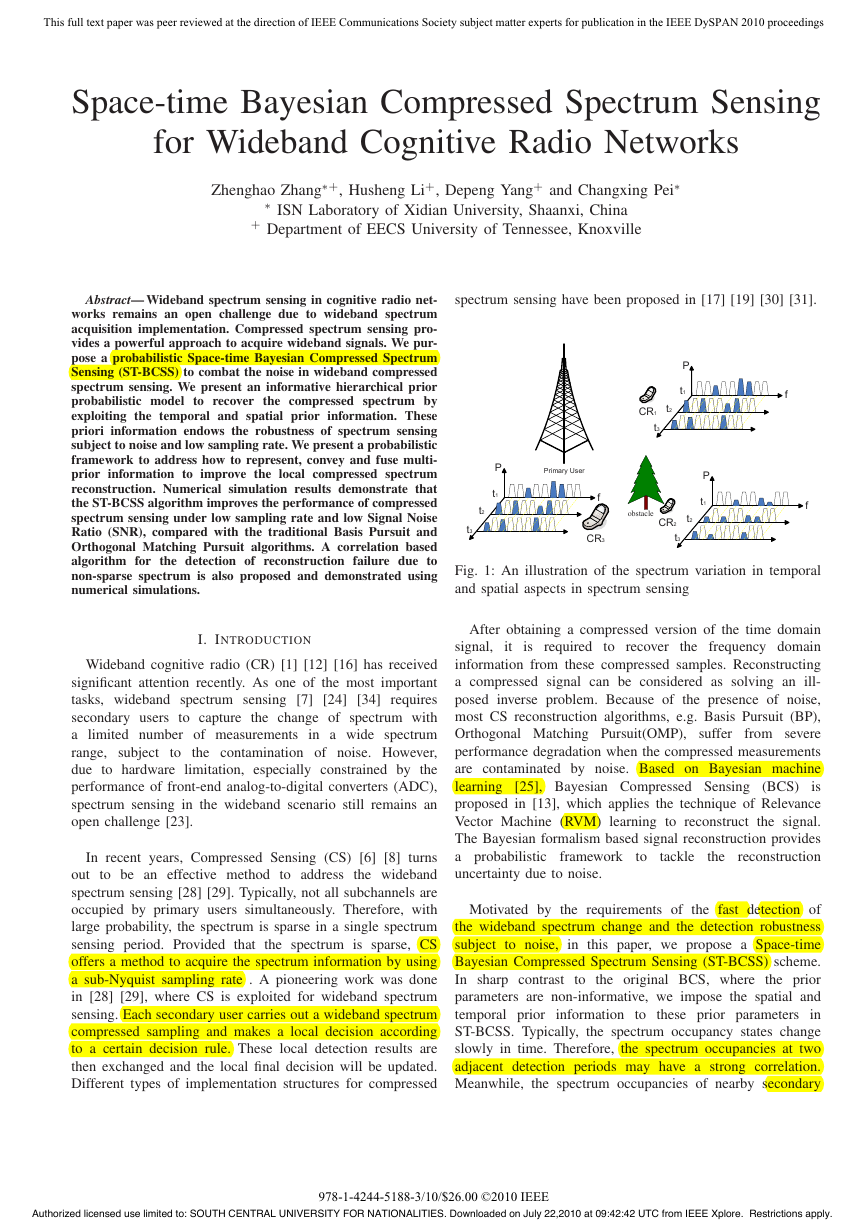
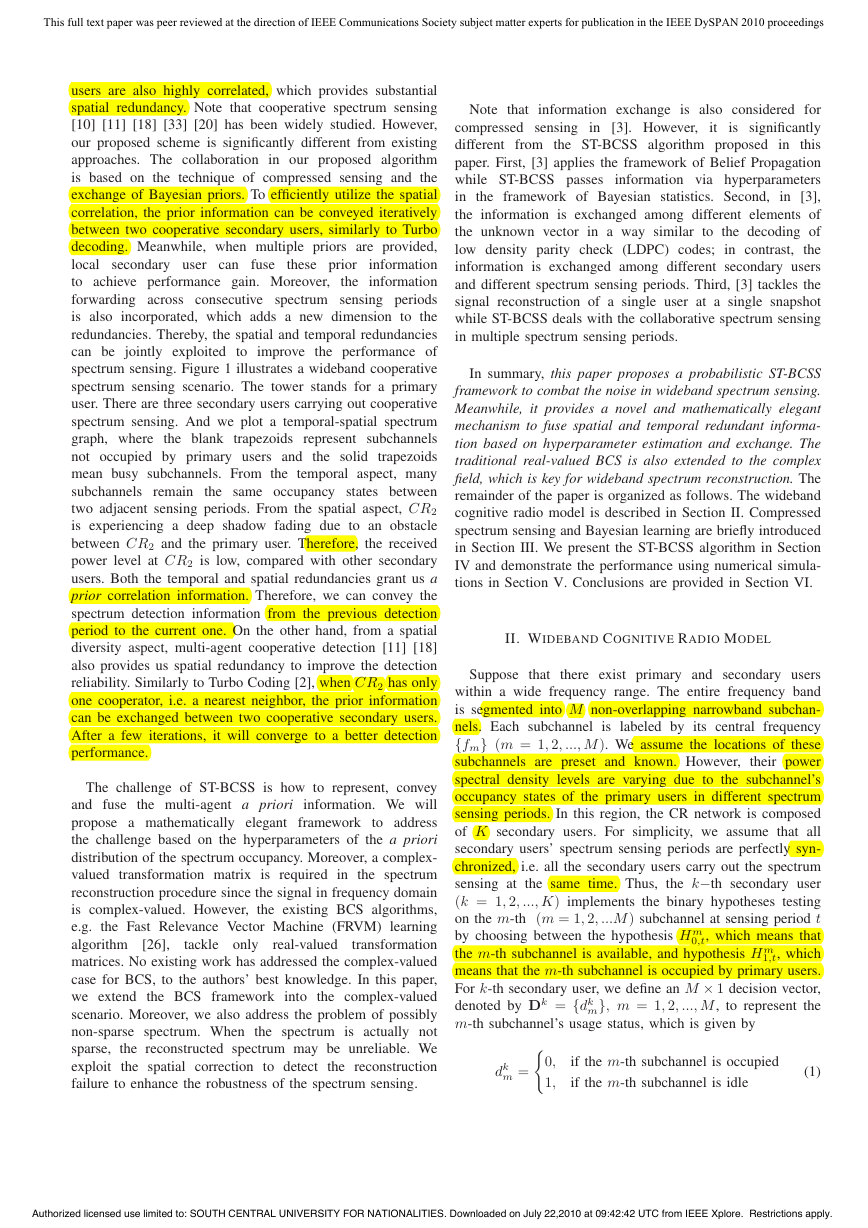
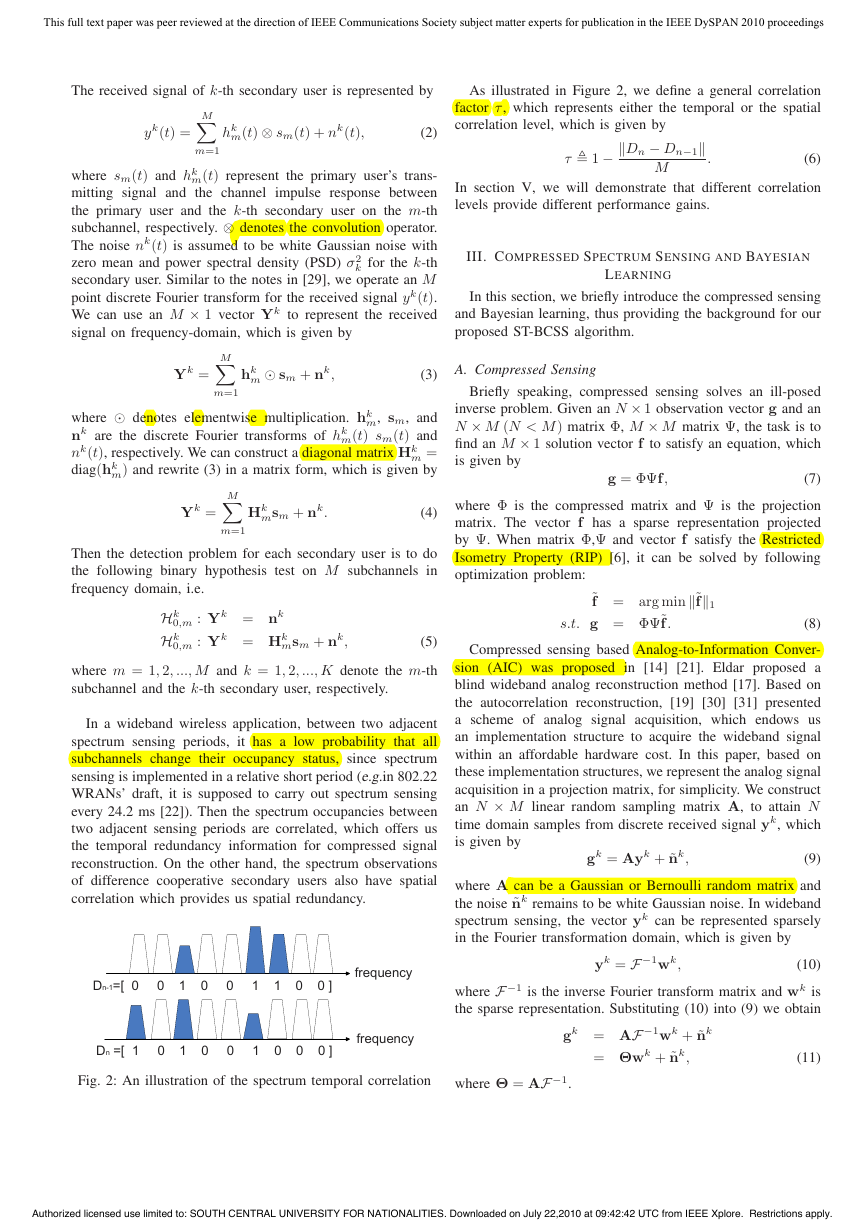
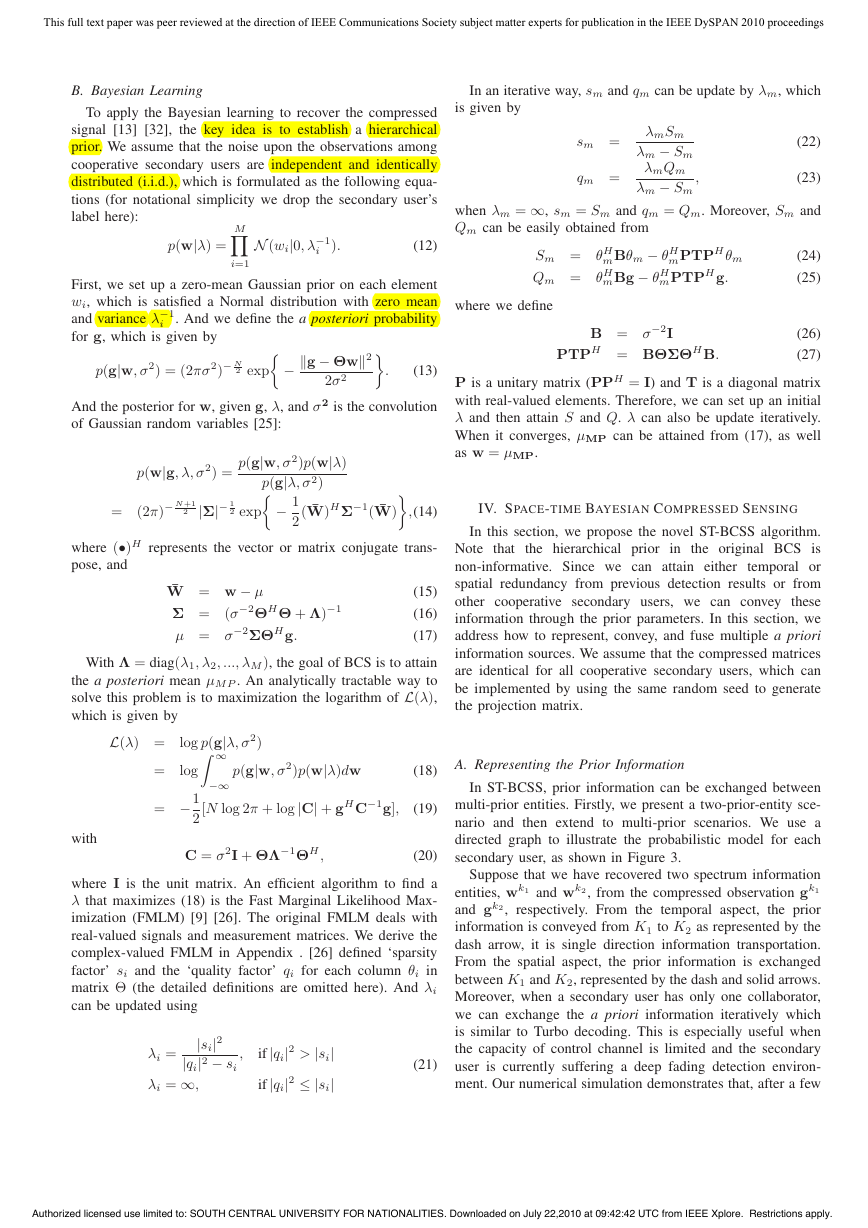
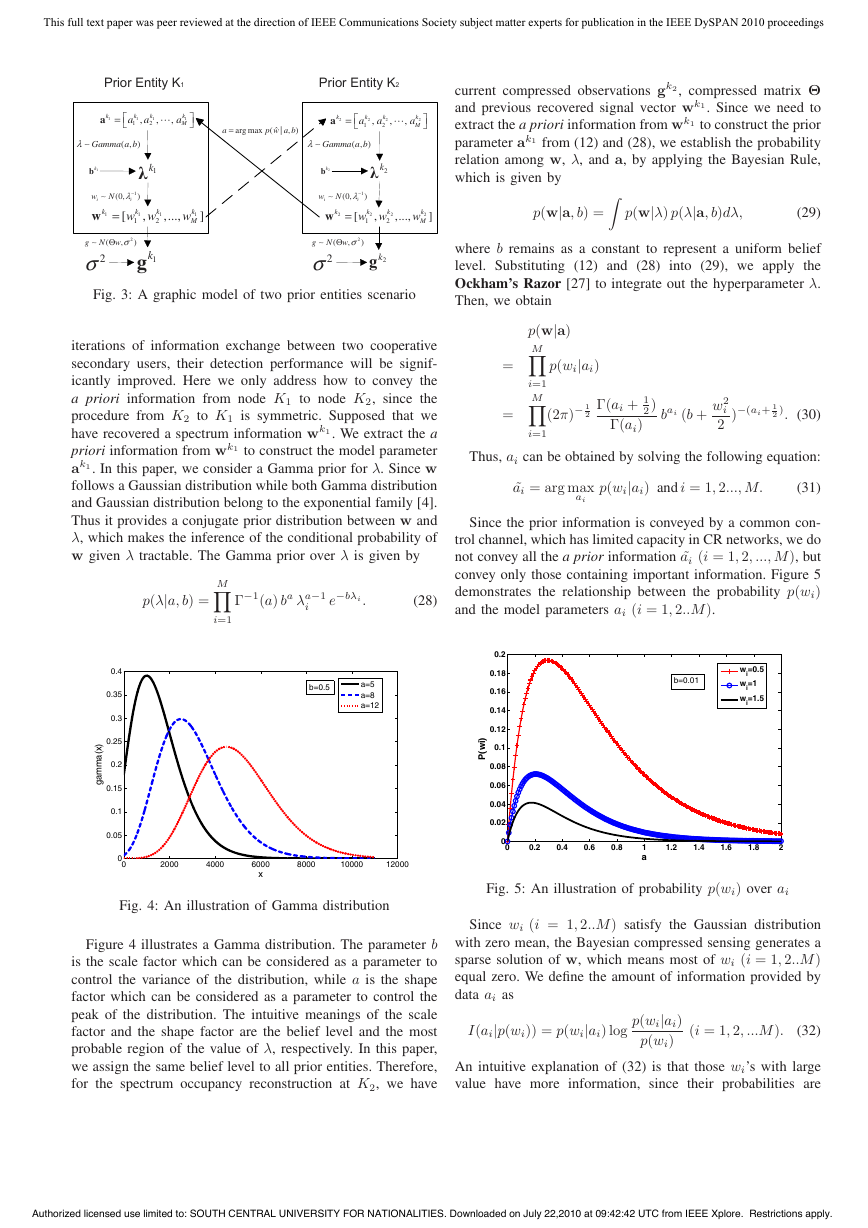

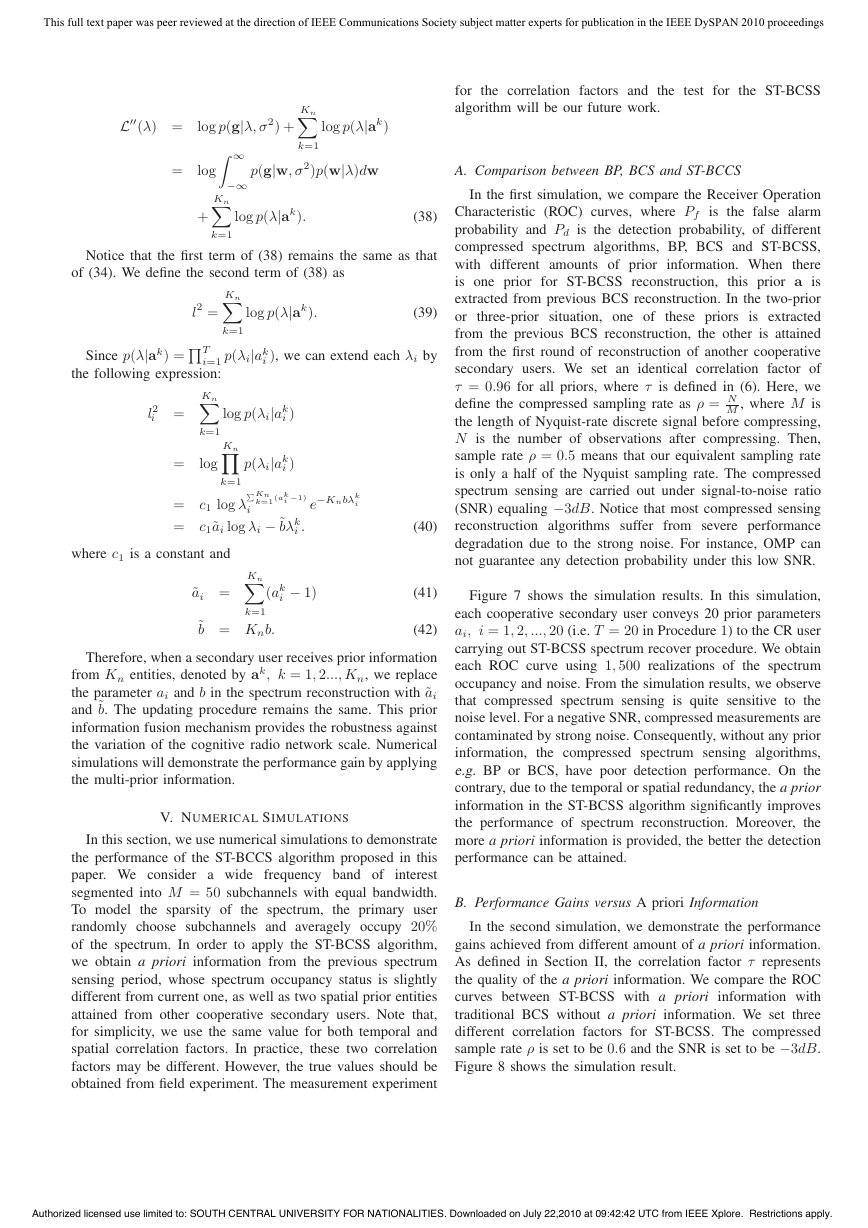
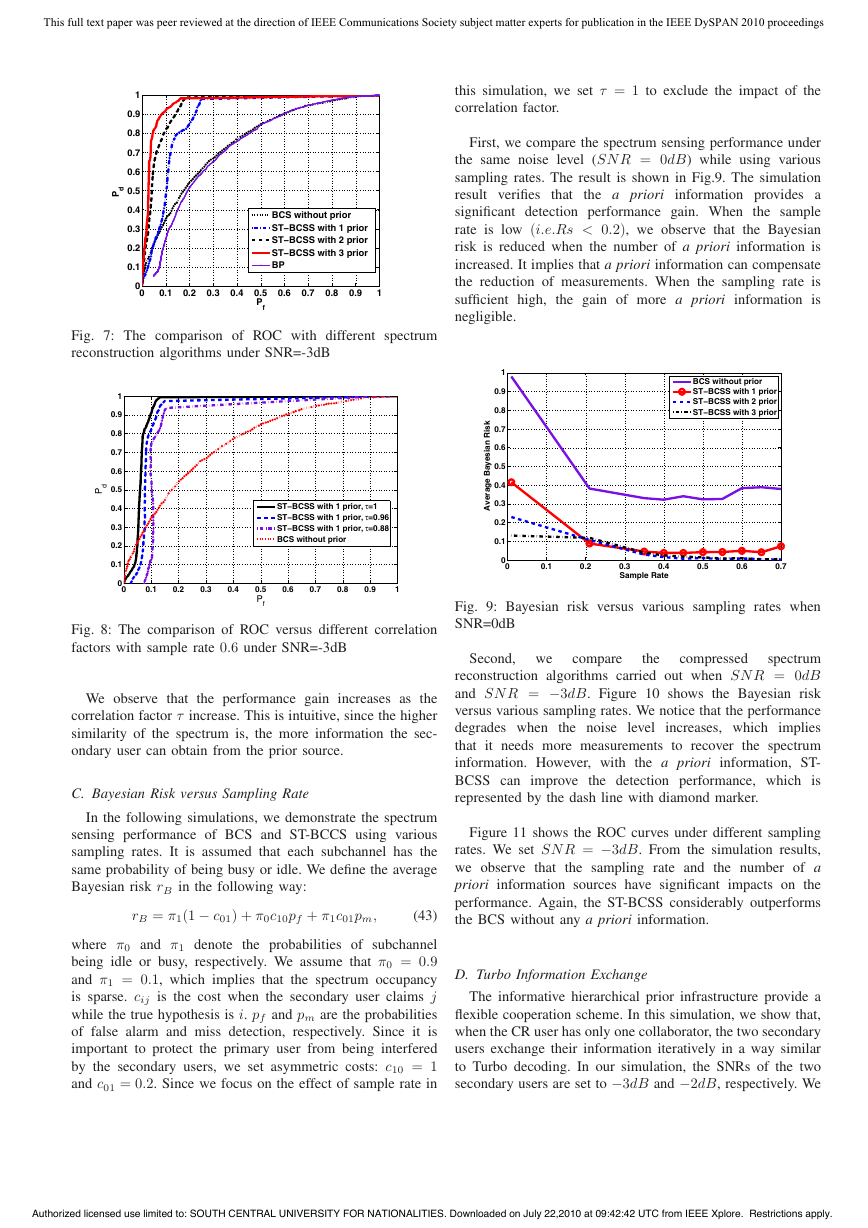








 2023年江西萍乡中考道德与法治真题及答案.doc
2023年江西萍乡中考道德与法治真题及答案.doc 2012年重庆南川中考生物真题及答案.doc
2012年重庆南川中考生物真题及答案.doc 2013年江西师范大学地理学综合及文艺理论基础考研真题.doc
2013年江西师范大学地理学综合及文艺理论基础考研真题.doc 2020年四川甘孜小升初语文真题及答案I卷.doc
2020年四川甘孜小升初语文真题及答案I卷.doc 2020年注册岩土工程师专业基础考试真题及答案.doc
2020年注册岩土工程师专业基础考试真题及答案.doc 2023-2024学年福建省厦门市九年级上学期数学月考试题及答案.doc
2023-2024学年福建省厦门市九年级上学期数学月考试题及答案.doc 2021-2022学年辽宁省沈阳市大东区九年级上学期语文期末试题及答案.doc
2021-2022学年辽宁省沈阳市大东区九年级上学期语文期末试题及答案.doc 2022-2023学年北京东城区初三第一学期物理期末试卷及答案.doc
2022-2023学年北京东城区初三第一学期物理期末试卷及答案.doc 2018上半年江西教师资格初中地理学科知识与教学能力真题及答案.doc
2018上半年江西教师资格初中地理学科知识与教学能力真题及答案.doc 2012年河北国家公务员申论考试真题及答案-省级.doc
2012年河北国家公务员申论考试真题及答案-省级.doc 2020-2021学年江苏省扬州市江都区邵樊片九年级上学期数学第一次质量检测试题及答案.doc
2020-2021学年江苏省扬州市江都区邵樊片九年级上学期数学第一次质量检测试题及答案.doc 2022下半年黑龙江教师资格证中学综合素质真题及答案.doc
2022下半年黑龙江教师资格证中学综合素质真题及答案.doc